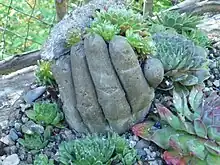Hypertufa
Hypertufa is an anthropic rock made from various aggregates bonded together using Portland cement.

Hypertufa is intended as a manufactured substitute for natural tufa, which is a slowly precipitated limestone rock; being very porous, it is favorable for plant growth.
Hypertufa is popular for making garden ornaments, pots and land forms. It is relatively light compared with terracotta or traditional concrete and can withstand harsh winters, at least down to −30 °C (−22 °F).
Hypertufa was invented for use in alpine gardens. Alpine gardeners formerly used antique animal watering troughs, which became rare and expensive.
Composition

Aggregates are generally Sphagnum (peat moss), sand, and perlite or vermiculite.[1] Coconut coir is coming to take the place of sphagnum moss, as the latter is a very slowly renewing natural resource and the former is a ready byproduct of the coconut industry— it has all the advantages of the moss but without the environmental costs.[2]
To increase structural strength and longevity, polymer fibers, liquid acrylic,[3] and fiberglass[4] may be incorporated into the mixture, along with various grades of sand, pebbles, and crushed rock which add to the final object's overall strength and stone-like appearance though they increase its weight. Powdered concrete dyes (in small amounts) also tint the hypertufa to resemble natural rock.[3]
Example
An example of a hypertufa mortar mix (with classic proportions) is a 1:3 mix of cement-to-aggregate, given by a composition of:
- Three parts type I Portland cement
- Four parts sphagnum or coir
- Five parts perlite
Restated: Three parts cement to nine parts aggregate (by volume, not weight, very rough measure).[3]
Manufacture
After water is added to the mixture, it is packed into a previously constructed mold, then sealed or covered in plastic and allowed to cure. The object may be carefully removed from its wrapping after 2–3 days for trimming and/or distressing, after which it is re-wrapped for another 3–5 days, at which time it is no longer considered "green" and can be handled & worked without danger of breakage. It is then re-wrapped, moistened if necessary & left to cure for a month. The longer the cure, the stronger the hypertufa. After the hypertufa object is completely cured, it is removed from the plastic, rinsed thoroughly, and allowed to sit exposed to the elements for several more weeks to reduce its otherwise-toxic surface alkalinity. It can then be used to hold plants.[5]
See also
References
- Calhoun, Scott; Lynn Hassler (2009). Hot Pots: Container Gardening in the Arid Southwest. Rio Nuevo Publishers. p. 19. ISBN 978-1-933855-39-4.
- Lorene Edwards Forkner (5 June 2012). Handmade Garden Projects: Step-by-Step Instructions for Creative Garden Features, Containers, Lighting & More. Timber. p. 133. ISBN 978-1-60469-375-1.
- Fingerut, Joyce (2003). Mary Jane McGary (ed.). Rock Garden Design and Construction. Timber Press. pp. 159–160. ISBN 978-0-88192-583-8.
- Building Garden Ornaments: 24 Do-It-Yourself Projects to Accent Any Setting. Creative Publishing International. 2000. p. 102. ISBN 978-0-86573-590-3.
- The editors of Creative Publishing international (2003). The Complete Guide to Finishing Touches for Yards & Gardens (Illustrated ed.). Creative. p. 183. ISBN 1-58923-144-9.
{{cite book}}:|last=has generic name (help)
External links
- Video and text instructions
- Gardenweb forum discussing Hypertufa techniques
- Drought Smart Plants Hypertufa What to plant in your finished project.